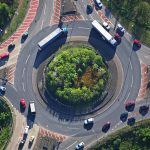US aid cut: A wake-up call for SA?
US aid cut: A wake-up call for SA?
The withdrawal of US aid exposes deep flaws in South Africa’s economic management. NICK PORÉE says that, with bloated government salaries draining resources, infrastructure failing, and transport systems in crisis, urgent reform and private investment are the only solutions.
The new US Republican elephant (clearly in musth) might still turn out to be a white elephant for the US. But his overreactions certainly touch on the woke, and delicately avoided, reality of the extensive diversion of foreign aid into government coffers and expenses throughout Africa. The pigs continue to eat the apples and drink the milk.*
In South Africa, the withdrawal of US aid adds another dimension to the improvidence of our economic management, and as usual, is likely to cause the most serious problems for the poorest in the population. The country is rapidly approaching a point where a serious organisational analysis is needed of the senior management in government; using a job evaluation system such as Paterson, which immediately clarifies who has a real executive job to do, and those who merely fill a position.
In many departments, the lack of budget has highly-paid officials sitting in offices since the Covid era, with nothing to do, as there is no money for anything but basic activities. At the coalface between lower levels of government and the public, officials in many departments – including police, home affairs, municipalities, hospitals, and courts – are battling to perform their functions with diminishing resources and no effective management, while a pressing mass of exalted seniors spend their time in committees and the sideline business of negotiating expenditures to their best advantage.
The cost of government is likely to become the major barrier to industrial recovery and expansion, and nowhere is this more evident than in the field of transport. The cost to pay public servants is the largest component of government spending – so 37% of the government’s spending in 2025 will compensate just 2% of the population (about 1.3 million public servants). The remuneration cost will limit spending on goods and services in hospitals, schools, and police stations, and decimate budgets for pro-growth infrastructure projects.
In the fields of transport and logistics, the people who undertake the daily operations at our antiquated, dilapidated, and inefficient ports perform heroically, given the condition of the systems and equipment. In the absence of professional terminal revitalisation, there is a gradual replacement of scrap equipment but no visionary future plans to modernise the systems and the management. In contrast, in Brazil, as part of the fast-tracked sell-off scheme, 22 terminals are expected to be auctioned between now and the end of 2025. This is a significant step in the country’s broader strategy to modernise and enhance its port infrastructure through private investment, aiming to boost efficiency and competitiveness in global trade.
At our land borders, the officials do what they can in the absence of the massive upgrading and re-equipping needed to manage the traffic volumes. The glacial speed and myopic approach of government planning, alongside the lack of funds, require a total policy transition to private sector investment and development – as in Zimbabwe and the Democratic Republic of Congo (DRC). In East Africa, our research and analysis at many borders has shown that border upgrades and transitions to the One-Stop Border Post (OSBP) system introduce efficiencies and reduce time and cost.
The railway’s R78-million-a-year executive is pouring further borrowed funds into trying to improve service levels, despite the appalling condition of the tracks and trains. The latest Transnet Railway Infrastructure Manager (TRIM) plans are based on a future of continued state-owned companies (SOCs) and their management of the railways, despite the disastrous historical failures. The process to create a commercially competitive private sector railway system has yet to break free of the yoke of governmental adherence to the loss-making SOCs, which have cost South Africa over R600 billion in debts, infrastructure deterioration, and loss of trade.
There are issues with airport traffic control due to staffing shortages and mismanagement of training in Air Traffic and Navigation Services (ATNS). The ATNS problems have negative impacts on aviation safety and, like the Road Traffic Management Corporation (RTMC), can potentially reduce it to the lamentable level of road safety in comparison to developed countries.
In road freight, operators continue to manage as best they can with the skills levels of staff available and the cost hurdles of fixed fees, levies, and charges. Driver training is very poor and technician training is disastrous, thanks to the collapse of the apprenticeship system and the educational barriers to advanced technical training.
Practical transport managerial training by industrial experts was cancelled at the University of Johannesburg in about 1996 and there is no authority mandated to control transport operational quality. There is also no monitoring of operator performance, except via the Vehicle Overloading Management System (VOMS) – a specialised tool developed by the Council for Scientific and Industrial Research (CSIR) to address the challenges posed by heavy vehicle overloading on road infrastructures.
Overloading significantly accelerates road deterioration, leading to increased maintenance costs and potential safety hazards. VOMS was designed to monitor, analyse, and manage overloading by utilising data from weighbridges across the country. Alas, when the system identifies repeat offenders there is no process to apply sanctions, save for one-off fines. It is no wonder that about 60% of road freight vehicles are unroadworthy and the 17,000 to 20,000 operators are not even identifiable, let alone regulated.
The various pressures on the industry from climate change, fuel supplies, vehicle prices, parts availability, and staffing quality are likely to be worsened by trade frictions, taxation, and emigration. At the same time, it will be necessary to maintain a very realistic surveillance of trends that are playing out internationally that may be impractical in South Africa. For instance, if there was very serious uptake in electric road vehicles, there would be increased grid failures and industrial power outages in all cities, as fast charging requires sophisticated systems. For long-haul freight, the implications of sparsely located recharge points and the impracticality of establishing high voltage charging in remote locations will impose barriers.
As a counterbalance to any euphoria about green energy, it is well to remember that most of the hardware in “renewables” (panels, frames, batteries, etc) have a lifespan ranging anywhere from about 10 to 30 years. They must then be 100% replaced – which makes one wonder about the so-called “renewable energy”.
Visions of green hydrogen production in South Africa must be tempered by the fact that total farming debt has increased by 8% and is estimated at R216.7 billion for the year ended June 2024, compared to R200.6 billion at the end of June 2023.
There are between 1.6 and 1.8 million hectares of undeveloped land in the Limpopo, KwaZulu-Natal, and Eastern Cape provinces, but the potential for profitable cropping is hampered by climatic, financial, logistical, and social barriers to efficient large-scale agricultural development and processing.
South Africa could have had world-class modern container terminals at all of its ports, with efficient access routes and nationwide commercial railway operations, for a fraction of the money wasted by Transnet. Maybe the US withdrawal of financial support will force a more pragmatic focus on what we can really do by sorting out our own systems. This includes encouraging immigration, entrepreneurship, and investment, as well as moving to the effective commercial management of transport and logistics, rather than further reliance on global loans and unaccountable bureaucratic enterprises.
* The phrase “The pigs continue to eat the apples and drink the milk” alludes to Animal Farm by George Orwell. In the novel, the pigs – who represent the ruling class – gradually take control and enjoy privileges at the expense of the other animals. They secretly consume milk and apples (initially meant for all) and when discovered, claim that this is necessary for their “brainwork” to manage the farm. This moment is an early example of the corruption and hypocrisy of leadership, a central theme in the book.
Published by
Nick Porée
focusmagsa




